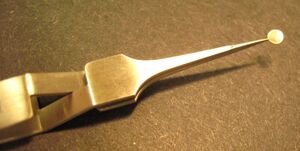20.109(F15):Phage nanowires (Day2)
Introduction
(Edited from material originally written by the Belcher lab. Special thanks to Mark Allen, and Lieutenant Colonel F. John Burpo.)

Assembly and testing of the phage-based battery will take place over several sessions. Today's lab will focus on material synthesis. Analysis of this material by TEM will be performed on the last day of the module. In the interim sessions, dried materials will be formed into electrodes, assembled into a coin-type battery, and tested. Groups will vary the amount of silver in the gold phage nanowires to see how these variations affect the charge/discharge cycle.
Today in lab you will calculate the concentration of phage stock you've prepared and then react it with gold and silver. You will have time while these reactions are going on to work on the research proposal idea you've got started with your lab partner.
Protocols
Part 1: Visit from BE Communications Lab
Today Vivian from the BE Communications Lab will join us to provide some tips for your research proposal presentation.
Part 2: Collect nanowires
Before you begin today's protocols, be sure to make some notes in your lab notebook about the appearance of the solution of nanowires. The next steps are devised to collect and wash the CTAB off the nanowires. You'll end up with some concentrated nanowires to observe by TEM and also to dry for assembly into a battery next time.
- Vortex the 50 ml falcon tubes and then sonicate the nanowires for 2 minutes. This step will break up large clumps of nanowires that may have formed.
- Centrifuge your 50 ml falcon tubes in the clinical centrifuge at 3K for 10 minutes.
- Pour off the supernatant and resuspend the pellet in 1 ml of sterile water. You may need to vortex to resuspend the nanowires in the water.
- Move 0.1 ml of your nanowires to an eppendorf tube and pool with any other team using same concentration of Ag+. Use this pool of nanowires for Part 2 of today's protocol.
- Add 9 ml of 100% EtOH to the remainder of the nanowires for Part 3 of today's protocol. Note that Part 2 and Part 3 of today's protocol can be done in parallel.
Part 3: TEM sample preparation
Each group should prepare a TEM grid. This will allow for some duplicates to be visualized in case the grid is damaged or different kinds of EM are being performed.
- Vortex the nanowire pool for 1 minute at least and immediately remove 10 ul of the nanowire suspension to place on the silver/black side (not the copper-looking side) of the TEM grid that you have balanced in the specialized tweezers. Treat the grid with care and use the tweezers only on the edge to minimize damaging the delicate mesh.

TEM grid balanced in tweezers, wrong side up! - Allow the nanowires to settle onto the grid undisturbed for 20'.
- Remove the droplet from the grid by touching the edge with a Kimwipe thereby wicking the solution off the grid.
- Wash the grid by adding 10 uL of sterile H2O onto the grid.
- Allow the grid to sit with water for 3 minutes and then wick dry.
- Wash the grid by adding 10 ul of 100% EtOH onto the grid.
- Allow the grid to sit with EtOH for 3 minutes and then wick dry, if it hasn't air dried.
- Place the grid into the TEM grid holder to transport to the TEM facility (13-1012). Angie will be in the facility to examine your samples with you.
Part 4: Harvesting the remainder of your nanowires
- Pool your sample with any group experimenting with the same ratio of gold and silver as you have tested.
- Centrifuge the sample of nanowires in EtOH using the clinical centrifuge (3K 10').
- Decant the supernatant and add 20 mL of sterile water and resuspend the centrifuged materials by vortexing if necessary.
- Harvest using the clinical centrifuge (3K 10').
- Decant the supernatant and add 20 ml of 100% EtOH to resuspend the nanowires.
- Harvest the nanowires in the clinical centrifuge one last time (3K 10').
- Decant the supernatant and wash the nanowires into a mortar with 100% EtOH.
- Allow the nanowires to settle and remove the clear solution above them with a 1 ml pipetman.
- Loosely cover the mortar with aluminum foil and set the covered mortar in the 30° incubator until next time. The majority of the EtOH will evaporate at 30°, though a vacuum oven will be used to fully dry the nanowires for next time.
Reagents list
- 0.1 M solution of hexadecyltrimethylammonium bromide ("CTAB")
- 10 mM hydrated hydrogen tetrachloroaurate (HAuCl4•3H2O)
- 10 mM silver nitrate (AgNO3)
- 0.1 M ascorbic acid
Navigation links
Next day: Battery assembly
Previous day: Growth of phage materials
